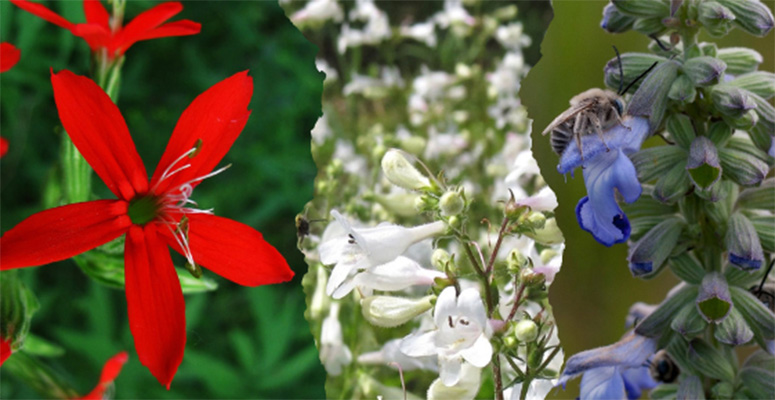
What could be a more patriotic way to garden than by using our homegrown American native plants? What You Plant Matters – and every year more and more gardeners are choosing native plants to beautify their homes and provide for pollinators, butterflies and birds. Here we highlight some of our favorites in red, white and blue.
For Sun

Royal Catchfly – Silene regia
Height: 24 – 36 inches
Spread:12-18 inches
Bloom time: June – August
Sun:Full sun
Moisture: Average to dry
Wildlife: Hummingbirds, butterflies
Why we love it: Long lasting and vibrant red blooms, great wildlife value. Related to carnivorous plants like the Venus Flytrap, Royal Catchfly takes its name from sticky hairs that cover the stems and catch small insects. Although the plant does not absorb nutrients from the insects, it does secrete enzymes that “digest” them away.

Foxglove beardtongue – Penstemon digitalis
Height: 30 – 48 inches
Spread:16-18 inches
Bloom time: May – June
Sun:Full sun – light shade
Moisture: Average to moist
Wildlife: Bees, hummingbirds
Why we love it: Gorgeous stands of delicate white tubular flowers herald spring’s end and summer’s arrival. A steady stream of pollinators visit, followed by attractive reddish seed heads that give structural interest during the late summer months.

Blue sage – Salvia azurea
Height: 3 – 5 feet*
Spread:16 – 20 inches
Bloom time: August – September
Sun:Full sun
Moisture: Dry to average
Wildlife: Bees, hummingbirds. The blue sage bee is completely dependent on the pollen of this plant as it’s only food source.
Why we love it: Deer resistant, attracts bees, butterflies and hummingbirds. Looks fantastic with the goldenrods that also bloom during the late season. *Can be cut back until July for a shorter, bushier plant.
For Shade

Columbine – Aquilegia canadensis
Height: 24 – 36 inches
Spread:16 – 20 inches
Bloom time: April – June
Sun: Shade – Medium Sun
Moisture: Dry to average
Wildlife: Attracts hummingbirds, bees.
Why we love it: Early season blooms, attractive foliage all summer. Very nice in well-drained containers and woodland gardens.

Bloodroot – Sanguinaria canadensis
Height: 5 – 7 inches
Spread:5 – 10 inches
Bloom time: March – April
Sun: Full shade – Light sun
Moisture: Average to moist
Wildlife: Small pollinators visit, ants disperse seeds
Why we love it: Striking green and white against a carpet of last year’s fallen leaves. Roots contain a red pigment used by Native Americans for dyes. Myrmecochoryis fun to say.

Virginia bluebells – Mertensia virginica
Height: 12 – 24 inches
Spread:16 – 24 inches
Bloom time: April – early May
Sun: Full shade – Light sun
Moisture: Average to moist
Wildlife: Early season nectar source for pollinators, butterflies
Why we love it: Buds change from purples and pinks to blue as they bloom. The whole plant goes dormant at the end of spring, allowing other species in the garden to take the stage before it returns next spring, gently spreading a little more each time.
Photo Credits:
Header composite photo from left –USFWS CC license, Tom Schroder, Courtney Masterson
Royal Catchfly – USFWS CC
Foxglove Beardtongue – Tom Schroeder
Blue sage with blue sage bee – Courtney Masterson
Columbine – USFWSCCcredit Kent Mason
Bloodroot – stock photo
Bluebells – ClifCC







